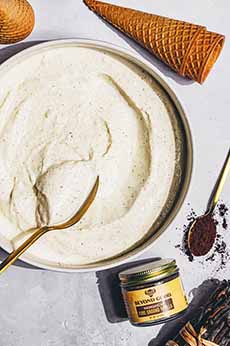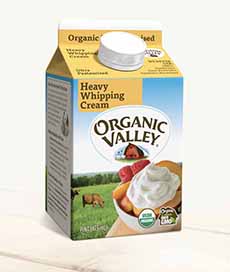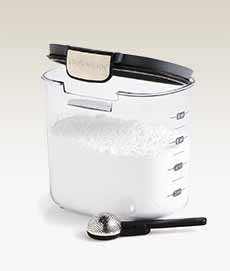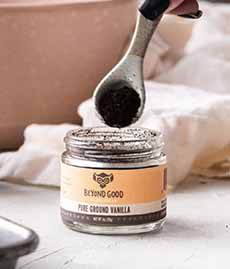Make Vanilla Soft Serve In Your Blender With 3 Ingredients
|
|
Get ready for National Soft Serve Day, August 19th. You can whip up a dessert or snack of vanilla soft serve with just three ingredients. The third ingredient is ground vanilla, a form of vanilla that many kitchens may not have (photo #4). But it’s well worth getting a jar of it, as you’ll see below. You can also make your own vanilla powder. > The different types of vanilla. > The history of soft serve (frozen custard). > See more uses for vanilla bean powder below. Thanks to Beyond Good for the recipe. Beyond Good is a company with a mission not only to source the best quality vanilla and cocoa in the world but to buy it directly from the farmers who grow it. In this way, the farmers make a good living, without giving a large share of their income to middlemen. The company hopes that its business model has the power to change the food industry, forever. Ingredients 1. COMBINE the cream, sugar, and vanilla powder in a Ziplock bag. Seal the bag well and shake to combine. 2. PRESS out all the air and lay the bag flat on a baking sheet. Freeze until firm. 3. BREAK the ice cream into chunks and place it in a blender or food processor. Process until the ice cream reaches a soft-serve consistency. 4. SERVE immediately or transfer the ice cream to a freezer-proof container and freeze until firm. Variations Mix in berries, chocolate chips, toffee bits, etc. Vanilla bean powder, also called vanilla powder and ground vanilla, is simply dried whole vanilla beans ground into a fine powder*. It has the consistency of powdered sugar (photo #4). It’s an easy way to add vanilla flavor to your recipes. You can use it instead of vanilla extract, vanilla bean paste, or whole vanilla beans. Vanilla powder flavor provides a much more concentrated vanilla flavor than either vanilla extract or vanilla paste, so you can use a bit less than these ratios—or enjoy a more intense vanilla flavor with the full ratio: Once you have a jar of vanilla powder, you’ll find a lot to do with it in both sweet and savory preparations. Cooks love to use it instead of vanilla extract when they don’t want to add additional liquid to a recipe, or when they don’t use alcohol†. Try it in: 1. DRY vanilla beans. You can either (a) leave the beans (pods) on a counter for a few weeks or (b) place them on a parchment-lined baking sheet or pan in a 125°F oven (50°C) for 1.5 hours. 2. GRIND the dried beans to a fine powder in a spice grinder. 3. STORE in an airtight container in a cool, dark place for up to a year. |
|
|
________________ *Some brands may add sugar or dextrose. Check the label to see that you are buying unsweetened vanilla powder. Some add cornstarch, dextrose, or maltodextrin, which helps keep the powder from clumping. †The FDA stipulates that vanilla extract must contain 35% alcohol, although much of it cooks out. However, since vanilla extract is made by soaking vanilla beans in alcohol, some of the vanilla flavor will bake out along with the alcohol. Vanilla powder retains the bean’s flavor compounds, while some of them in the vanilla extract will evaporate. CHECK OUT WHAT’S HAPPENING ON OUR HOME PAGE, THENIBBLE.COM.
|
||







